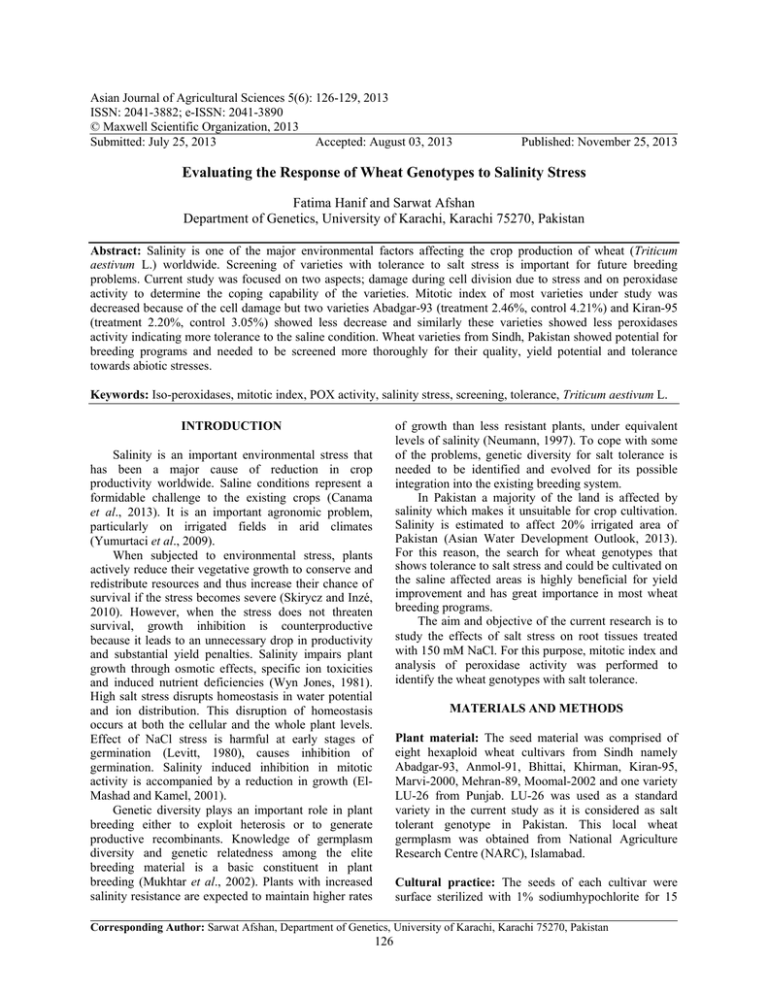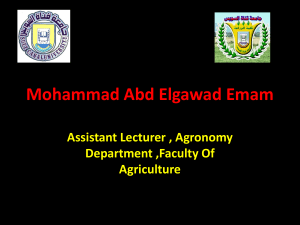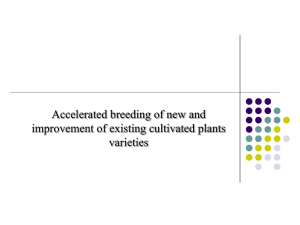Asian Journal of Agricultural Sciences 5(6): 126-129, 2013
advertisement

Asian Journal of Agricultural Sciences 5(6): 126-129, 2013 ISSN: 2041-3882; e-ISSN: 2041-3890 © Maxwell Scientific Organization, 2013 Submitted: July 25, 2013 Accepted: August 03, 2013 Published: November 25, 2013 Evaluating the Response of Wheat Genotypes to Salinity Stress Fatima Hanif and Sarwat Afshan Department of Genetics, University of Karachi, Karachi 75270, Pakistan Abstract: Salinity is one of the major environmental factors affecting the crop production of wheat (Triticum aestivum L.) worldwide. Screening of varieties with tolerance to salt stress is important for future breeding problems. Current study was focused on two aspects; damage during cell division due to stress and on peroxidase activity to determine the coping capability of the varieties. Mitotic index of most varieties under study was decreased because of the cell damage but two varieties Abadgar-93 (treatment 2.46%, control 4.21%) and Kiran-95 (treatment 2.20%, control 3.05%) showed less decrease and similarly these varieties showed less peroxidases activity indicating more tolerance to the saline condition. Wheat varieties from Sindh, Pakistan showed potential for breeding programs and needed to be screened more thoroughly for their quality, yield potential and tolerance towards abiotic stresses. Keywords: Iso-peroxidases, mitotic index, POX activity, salinity stress, screening, tolerance, Triticum aestivum L. of growth than less resistant plants, under equivalent levels of salinity (Neumann, 1997). To cope with some of the problems, genetic diversity for salt tolerance is needed to be identified and evolved for its possible integration into the existing breeding system. In Pakistan a majority of the land is affected by salinity which makes it unsuitable for crop cultivation. Salinity is estimated to affect 20% irrigated area of Pakistan (Asian Water Development Outlook, 2013). For this reason, the search for wheat genotypes that shows tolerance to salt stress and could be cultivated on the saline affected areas is highly beneficial for yield improvement and has great importance in most wheat breeding programs. The aim and objective of the current research is to study the effects of salt stress on root tissues treated with 150 mM NaCl. For this purpose, mitotic index and analysis of peroxidase activity was performed to identify the wheat genotypes with salt tolerance. INTRODUCTION Salinity is an important environmental stress that has been a major cause of reduction in crop productivity worldwide. Saline conditions represent a formidable challenge to the existing crops (Canama et al., 2013). It is an important agronomic problem, particularly on irrigated fields in arid climates (Yumurtaci et al., 2009). When subjected to environmental stress, plants actively reduce their vegetative growth to conserve and redistribute resources and thus increase their chance of survival if the stress becomes severe (Skirycz and Inzé, 2010). However, when the stress does not threaten survival, growth inhibition is counterproductive because it leads to an unnecessary drop in productivity and substantial yield penalties. Salinity impairs plant growth through osmotic effects, specific ion toxicities and induced nutrient deficiencies (Wyn Jones, 1981). High salt stress disrupts homeostasis in water potential and ion distribution. This disruption of homeostasis occurs at both the cellular and the whole plant levels. Effect of NaCl stress is harmful at early stages of germination (Levitt, 1980), causes inhibition of germination. Salinity induced inhibition in mitotic activity is accompanied by a reduction in growth (ElMashad and Kamel, 2001). Genetic diversity plays an important role in plant breeding either to exploit heterosis or to generate productive recombinants. Knowledge of germplasm diversity and genetic relatedness among the elite breeding material is a basic constituent in plant breeding (Mukhtar et al., 2002). Plants with increased salinity resistance are expected to maintain higher rates MATERIALS AND METHODS Plant material: The seed material was comprised of eight hexaploid wheat cultivars from Sindh namely Abadgar-93, Anmol-91, Bhittai, Khirman, Kiran-95, Marvi-2000, Mehran-89, Moomal-2002 and one variety LU-26 from Punjab. LU-26 was used as a standard variety in the current study as it is considered as salt tolerant genotype in Pakistan. This local wheat germplasm was obtained from National Agriculture Research Centre (NARC), Islamabad. Cultural practice: The seeds of each cultivar were surface sterilized with 1% sodiumhypochlorite for 15 Corresponding Author: Sarwat Afshan, Department of Genetics, University of Karachi, Karachi 75270, Pakistan 126 Asian J. Agric. Sci., 5(6): 126-129, 2013 in a mixture of 1% benzidine (in 18% acetic acid) and 0.1% H 2 O 2 . After the incubation period, the gel was rinsed with distilled water and was analyzed. min, rinsed with tap water and soaked in distilled water overnight. Seeds were allowed to germinate in laboratory condition on filter paper in petri dishes soaked in distilled water. Three days old wheat seedlings were transferred to the modified Hoagland’s (Hoagland and Arnon, 1950) solution supplemented with 150 mM NaCl for salt stress treatment. The hoagland’s solution was changed daily for aeration of roots during the treatment. For the control the Hoagland’s solution was with 0 mM NaCl. Quantitative estimation: Quantitative estimation of peroxidase was carried out according to the protocol of Everse et al. (1994) using UV-VIS Spectrophotometer. RESULTS Mitotic activity: The mitotic index of all wheat varieties under salt stress showed a clear decrease as compared to their controls. LU-26 (treatment 0.62%, control 4.25%) considered as a standard salt tolerant variety, showed more than twofold decrease comparing to Abadgar-93 (treatment 2.46%, control 4.21%), Kiran-95 (treatment 2.20%, control 3.05%) and Anmol91 (treatment 0.68%, control 2.68%). The comparison of mitotic index showed that these three varieties (Abadgar-93, Kiran-95 and Anmol-91) were able to withstand the salt stress and undergo mitotic division when treated with salt treatment (Fig. 1). While the rest of the varieties showed 100% decrease in the mitotic index; Mehran-89 (treatment 0%, control 4.13%), Moomal-2002 (treatment 0%, control 5.08%), Khirman (treatment 0%, control 3.05%), Marvi-2000 (treatment 0%, control 2.65%), Bhittai (treatment 0%, control 0.88%), were unable to survive salt stress at cellular level and demonstrate cell damage. Mitotic activity: The influence of salt stress on the rate of cell division on root tips of 150 mM salt treated group and control (0 mM NaCl) was obtained from the analysis of mitotic index. The root tips after 48 h of treatment were collected and fixed in the Carnoy’s solution of acetic acid-ethanol (1:3, v/v) for 24 h. After fixation the tips were placed into the staining solution of 1.8% aceto-orcein. Squash preparation were made and observed under the optical microscope. For the calculation of mitotic index approximately 1000 cells were scored. Qualitative analysis: Isozyme extraction was performed using control sample (0 mM NaCl), as well as from NaCl treated sample. A single seedling has been used of each wheat variety with three repeats for the qualitative analysis of iso-peroxidases using PAGE as described by Maurer (1971) with minor modification. Individual seedlings were grounded in 2 mL homogenizing buffer (20 mM Tris-HCl buffer, 3 mM Na-EDTA, 0.25 mM Sucrose and 0.2 mM betamercaptoethanol) and centrifuged at 14000 rpm for 25 min and supernatant was collected. Ten micro liters of extracted samples were used for PAGE using 7.5% running gel. The gels were stained according to the method of Scandalios (1974) modified by Nasir et al. (1985). Peroxidase was detected by incubating the gel Qualitative analysis of iso-peroxidases: Isoperoxidases in wheat varieties under treatment showed similar banding pattern as control samples. But there are differences in the densities of the bands when treated samples were compared with the control. LU-26 (Fig. 2) treated having denser band as compared to control. Similar pattern was observed in Mehran-89, Fig. 1: Mean percentage of mitotic index 127 Asian J. Agric. Sci., 5(6): 126-129, 2013 Fig. 2: Banding pattern of peroxidase enzyme of different varieties of wheat. 1-LU-26 cont, 2-Mehran cont, 3-LU-26 trt, 4Mehran trt, 5-Moomal cont, 6-Moomal trt, 7-Khirman cont, 8-Khirman trt, 9-Abadgar cont, 10-Abadgar trt Fig. 3: Mean square of specific peroxidase activity Khirman and Kiran-95 however in Abadgar-93 and Anmol-91 having less dense band sunder treatment. The band densities in Moomal-2002, Marvi-2000 and Bhittai are same in both conditions. The more intensity of banding pattern indicates high Peroxidase (POX) activity. The comparison of isoperoxidases showed no difference when it comes to their presence except more the densities of the bands observed. The sample with more cell damage due to stress environment will have more peroxidase activity. This way Abadgar-93 and Anmol-91 showed less peroxidase activity hence having more tolerance to survive under the stress. activity is usually increased to help to reduce the effect of injury to the plant. Thus the plant having more cell damage will have more peroxidase activity compared to the control. In the current study there is decrease in the peroxidase activity in Abadgar-93 (treatment 4.26 µg; control 4.43 µg), Kiran-95 (treatment 6.13 µg; control 11.7 µg) and LU-26 (treatment 3.3 µg; control 7.16 µg) (Fig. 3). This result correlates with the outcome of mitotic index for Abadgar, thus suggesting that from the local genotypes Abadgar-93 showing tolerance to saline stress. DISCUSSION Quantitative estimation of peroxidases: Quantitative estimation was performed to find out the activity of peroxidase when the seedlings were exposed to the saline condition. Due to the damage of cells the POX The rate of cell production is a determining factor for the rate at which an organ grows (Yumurtaci et al., 2009). Salt stress affects early stages of development in 128 Asian J. Agric. Sci., 5(6): 126-129, 2013 plants. Mitotic index is an important parameter to be determined as an alternative for the screening of root growth inhibition (Yumurtaci et al., 2007). The presented evidence indicates the mitotic index was decreased in majority of the varieties. Salt sensitive genotypes revealed more decline in mitotic index as compared to salt tolerant genotypes. Under 150 mM salinity stress majority of the cells of wheat varieties were damaged. According to the results, Abadgar-93 and Kiran-95 showed tolerance to salt stress while LU26, Moomal-2002, Marvi-2000, Mehran-89, Khirman, Anmol-91 and Bhittai can be considered as sensitive varieties. The challenge in plant biology is to identify those gene combinations that lead to major crop improvement (Moose and Mumm, 2008). Peroxidases activity is an important parameter to determine how well a variety act to control the damage occurred by any stress. But peroxidase activity cannot be the parameter alone to conclude it; there are other enzymes activities should also be taken into account for a final conclusion. Thus further detailed study of these varieties should be done to get precise information. But so far this study suggests that wheat varieties from Sindh have great potential under salt stress and should be focused for detail screening. Everse, J., M.C. Johnson and M.A. Marini, 1994. Peroxidative Activities of Hemoglobin and Hemoglobin Derivaties. In: Everse, J., K.D. Vandegriff and R.M. Winslow (Eds.), Methods in Enzymology. Academic Press, London, pp: 547-561. Hoagland, D.R. and D.I. Arnon, 1950. The Water Culture Method for Growing Plants without Soil. In: California Agricultural Experiment Station Circular 347. The College of Agriculture, University of California, Berkeley, CA, pp: 1-39. Levitt, J., 1980. Salt Stresses. Response of Plants to Environ mental Stresses. Vol. II. Academic Press, pp: 365. Maurer, H.R., 1971. Disc Electrophoresis and Related Techniques of Polyacrylamide Gel Electrophoresis. 2nd Edn.,Walter de Gruyter, Berlin. Moose, S.P. and R.H. Mumm, 2008. Molecular plant breeding as the foundation for 21st century crop improvement. Plant Physiol., 147: 969-977. Mukhtar, M.S., M. Rahman and Y. Zafar, 2002. Assessment ofgeneticdiversity among wheat (Triticum aestivum L.) cultivars from a range of localities across Pakistan using Random Amplified Polymorphic DNA (RAPD) analysis. Euphytica, 128: 417-425. Nasir, F., J. Ahmed and M.I. Khan, 1985. Expression of heterosis for biochemical traits in Raphanus sativus L.Z. Acker-und Pflanzenbau. J. Agron. Crop Sci., 115: 157-159. Neumann, P., 1997. Salinity resistance and plant growth revisited. Plant Cell Environ., 20: 1193-1198. Scandalios, J.G., 1974. Isozymes in development and differentiation. Ann. Rev. Plant Physiol., 25: 225-285. Skirycz, A. and D. Inzé, 2010. More from less: Plant growth under limited water. Curr. Opin. Biotechnol., 21: 197-203. Wyn Jones, R.G., 1981. Salt Resistance. In: Johnson, C.B., (Ed.), Physiological Processes Limiting Plant Productivity. Butterworths Press, London, pp: 271-292. Yumurtaci, A., F. Vardar and M. Unal, 2007. Inhibition of barley root growth by actinomycin D: Effects on mitotic activity, protein content and peroxidase activity. Fresen. Environ. Bull., 16: 917-921. Yumurtaci, A., Y. Aydin and A.A. Uncuoglu, 2009. Cytological changes in Turkish durum and bread wheat genotypes in response to salt stress. Acta Biol. Hung., 60: 221-232. ACKNOWLEDGMENT Grant from Dean Faculty of Science, University of Karachi supported this research study. REFERENCES Asian Water Development Outlook, 2013. ISBN: 97892-9092-988-8 (Print), 978-92-9092-989-5 (Web). Retrieved from: http://www.adb.org/ publications/ asian-water-development-outlook-2013. Canama, T., X. Li, J. Holowachukb, M. Yu, J. Xia, R. Mandal, R. Krishnamurthy, S. Bouatra, I. Sinelnikov, B. Yu, L. Grenkow, D.S. Wishart, H. Steppuhn, K.C. Falk, T.J. Dumonceaux and M.Y. Gruber, 2013. Differential metabolite profiles and salinity tolerance between two genetically related brown-seeded and yellow-seeded Brassica carinata lines. Plant Sci., 198: 17-26. El-Mashad, A.A. and E. Kamel, 2001. Amelioration of NaCl stress in Pisum sativum linn. Indian J. Exp. Biol., 39: 469-475. 129





